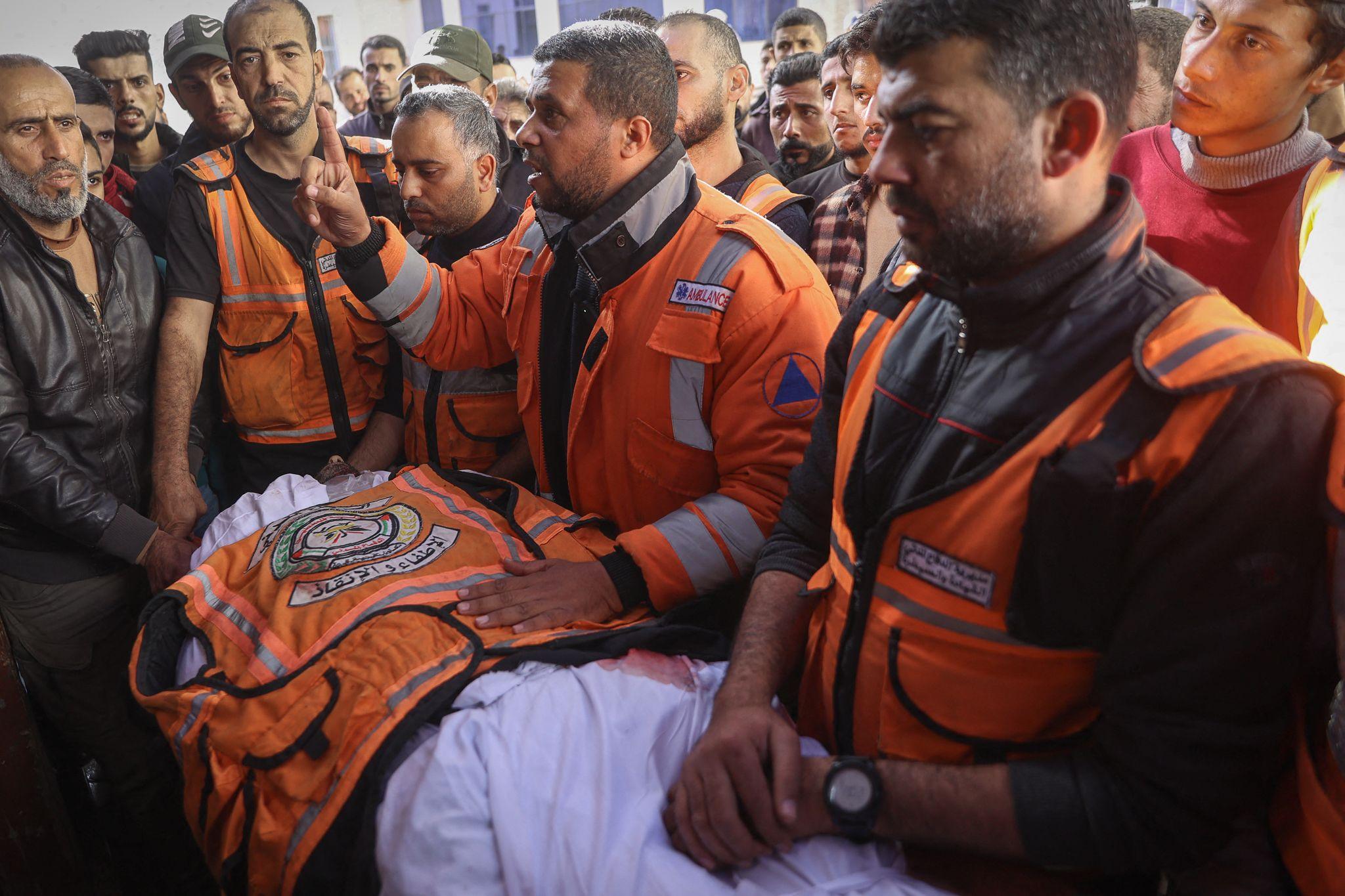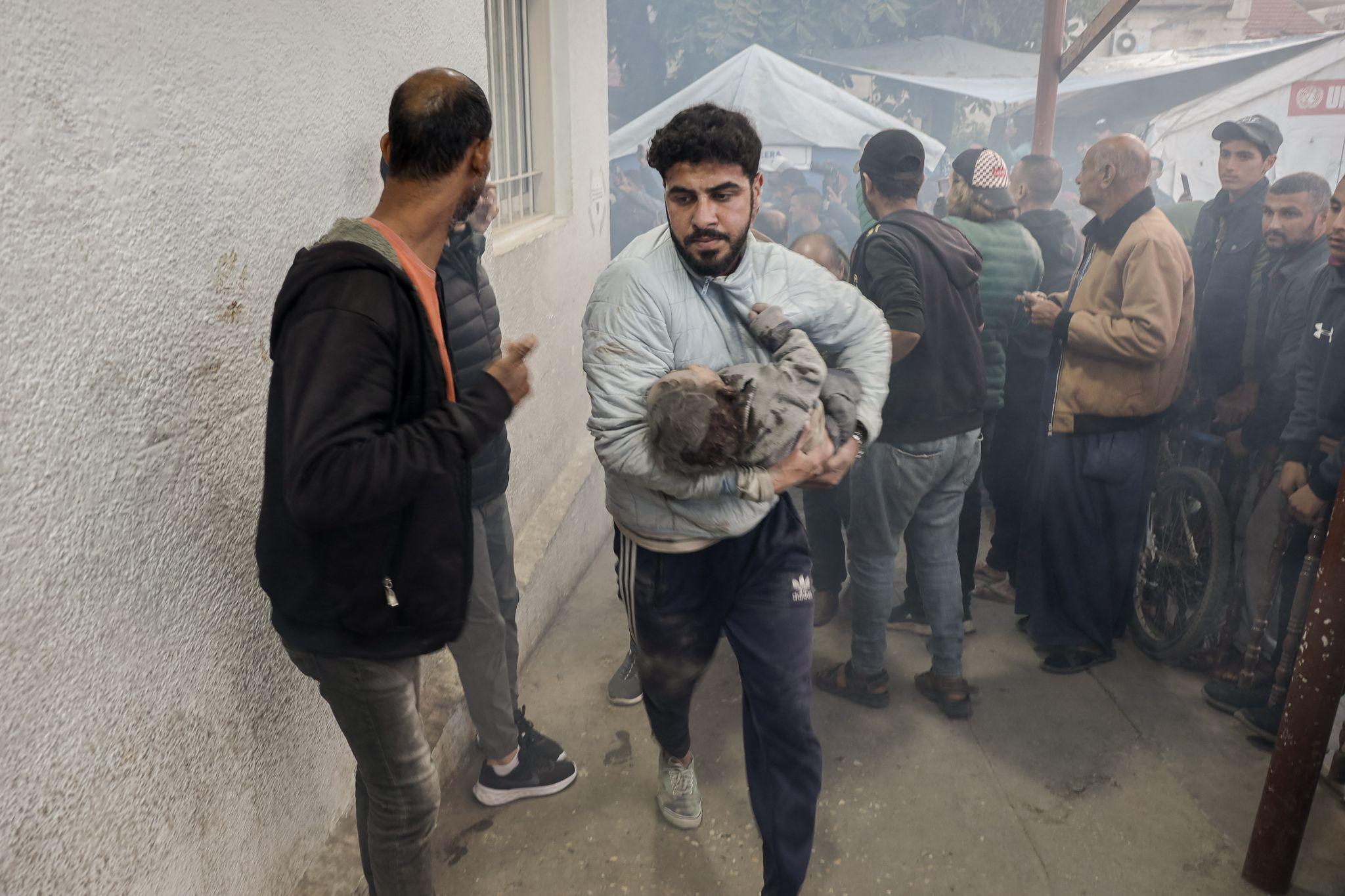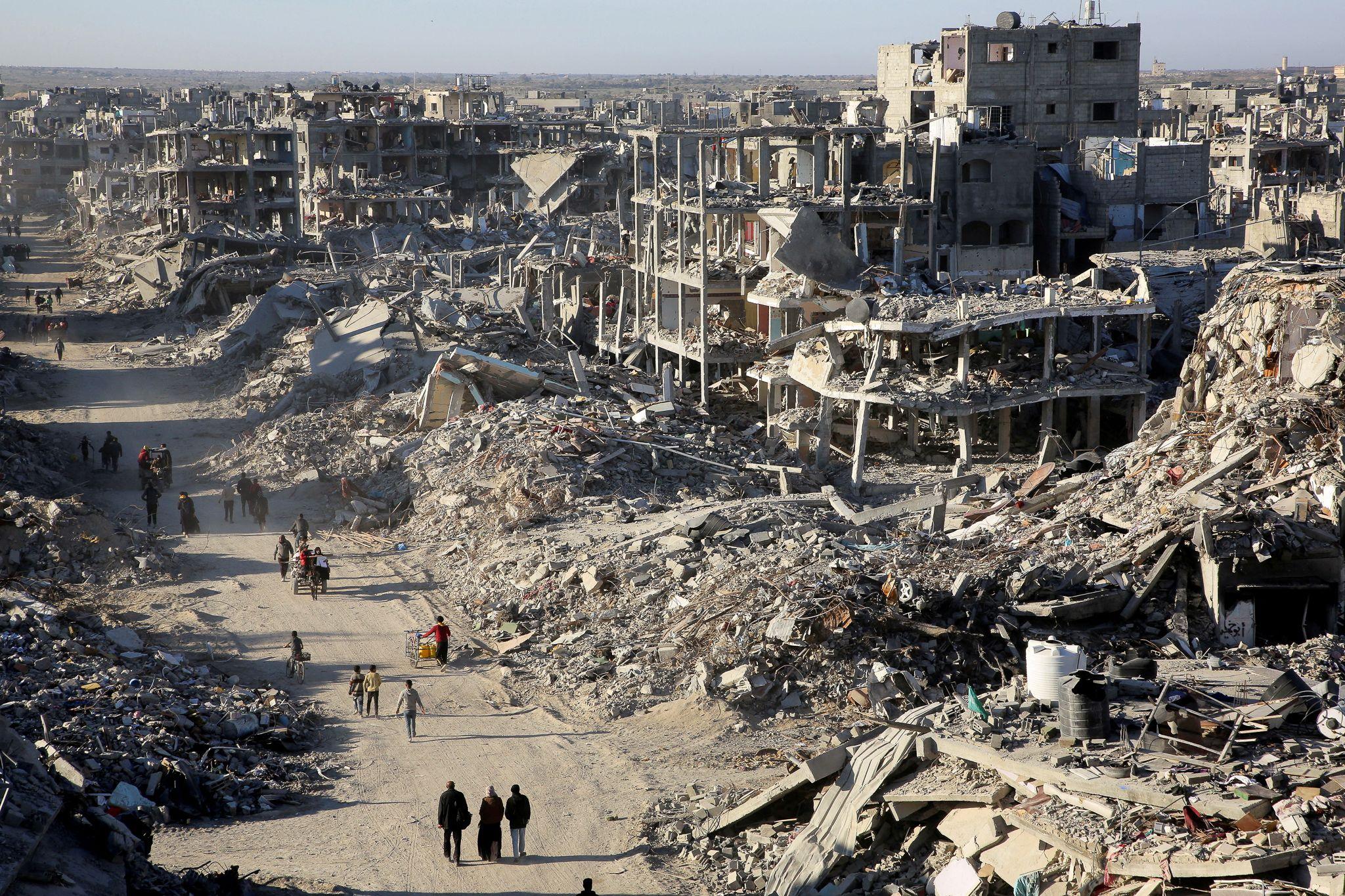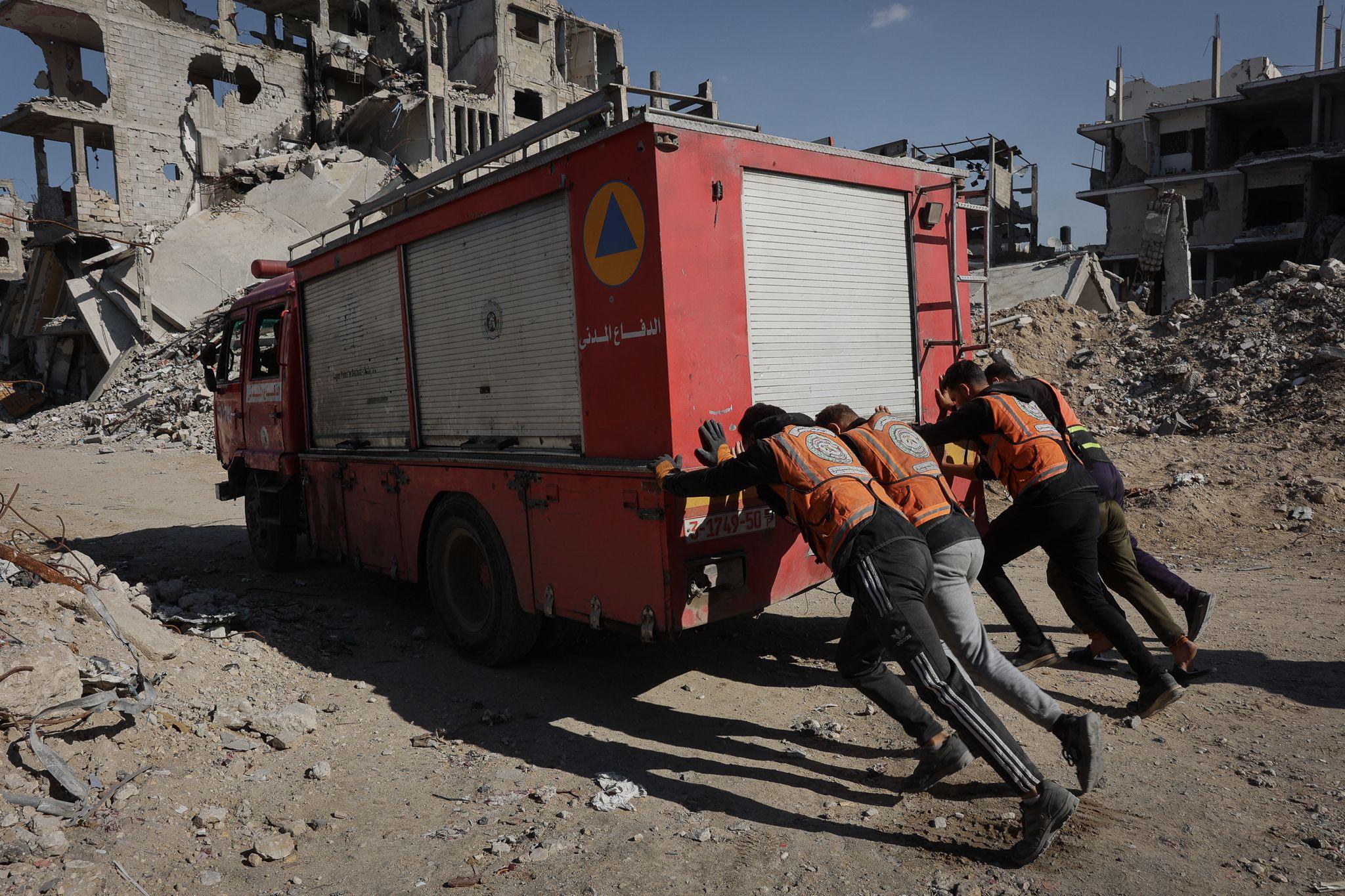Gaza rescuers face toll of their work: 'I have become afraid of my own memories'
- Published

At some of the many thousands of funerals in Gaza over the past 15 months, mourners have laid a bright orange vest over the body.
The vests are usually well worn and marked by dust, sometimes blood. They belong to the Civil Defence, Gaza's main emergency service.
Throughout the Israeli bombardment, the Civil Defence was responsible for pulling the living and the dead from the rubble. Along with Gaza's ambulance service, the rescue workers have taken on some of the most harrowing work in the strip.
And they have paid a steep price. The agency said on Monday that that 99 of its rescue workers had been killed and 319 wounded during the conflict - some with life-changing injuries.
When the Civil Defence buries its own, where possible the vests of the dead are laid on their bodies.
"We put the vest there because our colleague sacrified his soul in it," said Nooh al-Shaghnobi, a 24-year-old rescue worker, in a phone interview from Gaza City.
"We hope it will show God that this man did good with his life, that he saved others."

Members of the Gaza Civil Defence attend the funeral of a colleague who was killed alongside his son in an Israeli strike in Gaza City.
Israel killed more than 47,000 Palestinians in Gaza during the conflict - mostly women and children - and wounded more than 111,000, according to the Hamas-run health ministry, whose figures are seen as reliable by the UN. A recent study published by the Lancet medical journal found that the death toll during the first nine months of the war may have been underestimated by more than 40%.
The fragile ceasefire that came into effect last weekend is holding. But for the rescue workers of the Civil Defence, the next phase of their work is just beginning.
The agency estimates that there are more than 10,000 people buried under the vast sea of rubble across Gaza. The figure is based on information collected throughout the war about who was in each building destroyed by Israel, and who the agency knows to have been recovered already.
In areas that were completely occupied by Israeli forces during the destruction, they do not have detailed information and are relying on residents to help them. In the Tel el-Hawa neighbourhood of Gaza City on Tuesday, rescue worker Al-Shaghnobi found a man with information about the fate of a flattened apartment building.
"He told us seven dead were recovered, but there was an elderly gentleman, a child and an infant left behind," Al-Shaghnobi said.
"Fortunately there was a privately-owned bulldozer nearby and we were able to excavate the top layer of rubble," he said. "And underneath we found three skeletons that matched the description."

Rescue worker Nooh Al-Shagnobi rushes an injured child into the Al-Ahli Baptist Hospital in Gaza City.
Al-Shaghnobi has accrued a large following during the war by sharing his experiences on social media. Though he pixelates some images, others show the horrors he and other young rescue workers have faced.
One video shows him under the rubble, carefully extricating the body of an infant from around the body of another small child, who is alive. Other images he sent to the BBC show the extreme nature of the rescue work.
"You should become numb as time goes on," Al-Shagnobi said, during a shift in Gaza City. "But I have become worse. I feel more pain, not less. I find it harder to cope. I have seen 50 of my colleagues die in front of me. Who outside of Gaza can imagine this?"
As the first of the Israeli hostages were released from Gaza last week, in exchange for 90 Palestinians from Israeli jails, Israeli authorities described the extensive psychological support waiting for the returning hostages.
But for those experiencing horrors in Gaza, such support is extremely limited. None of the four rescue workers who spoke to the BBC this week from Gaza said they had been offered counselling.
"We all need this," said Mohammed Lafi, a 25-year-old rescue worker in Gaza City, "but no one talks about it."
Lafi, who has been with the agency for six years, has a wife and infant son at home. "When I pull the body of a baby from the rubble I scream inside myself if he is the same age as my son. My body shakes."

Displaced Palestinians walk past the rubble as they attempt to return to their homes in northern Gaza, on the day the ceasefire.
Even if counselling were to be widely available, "a year of therapy would not be enough for one day of this job," said Abdullah al-Majdalawi, a 24-year-old Civil Defence worker who lives with his parents in Gaza City.
Al-Majdalawi said that when he returned to his home between shifts he did small jobs and chores constantly, "because I have become afraid of my own memories".
"I am very solitary now," he said. "I do not really talk to others about what I have seen. But I feel that my whole body is becoming tight, and I need some kind of therapy because things are accumulating."
The Civil Defence workers had come to be viewed from the outside as heroes, Al-Majdalawi said. "But they do not see what is happening inside. Inside I am fighting a war against myself."
As the ceasefire began, new images from inside Gaza showed scenes of near-total destruction, particularly in the north of the enclave. Civil Defence spokesman Mahmoud Basal said that the agency hoped to recover the remaining dead from under the rubble within 100 days, but he acknowledged it was a difficult target, because they have virtually no bulldozers and other heavy equipment yet.
The Civil Defence has accused Israel of deliberately targeting and destroying its vehicles and equipment in strikes - an accusation Israel denies. Rescue workers told the BBC they were currently working with simple hand tools like hammers and had few working vehicles. "We have so little equipment we need another Civil Defence to rescue the Civil Defence," Al-Majdalawi said.
A spokesman for the agency said on Friday they had been able to recover just 162 bodies since the ceasefire began nearly a week ago.

Civil Defence rescuers push a fire truck amid destruction in the Shujaiyah neighbourhood in Gaza City in November.
The UN aid coordination office OCHA has warned that the recovery of the bodies could take years, owing to the lack of equipment, personnel, and what it estimates is 37 million tonnes of rubble littered with unexploded bombs and dangerous materials like asbestos.
The amount of time that many of the dead also hinders the identification process. At the European Hospital in Khan Younis in the south of Gaza, people were searching for loved ones this week among remains brought to the hospital and laid outside on white sheets. In many cases, the only option was to search for shoes, clothes or other personal effects.
"I believe I will recognise my son immediately, even if his face has no features and he is only a skeleton," said Ali Ashour, a university professor, of his 18-year-old boy Mahjoud.
"I will recognise him because I am his father and I know him better than a million people," he said.
Ashour still harboured hope that Mahjoud might have been taken prisoner, he said, but he planned to search the dead every day until he knew. "Any time they bring more remains I will come," he said. "And if I see my son I will lift him out from between the other bodies and carry him away."
Nisreen Shaaban was searching for her 16-year-old son Moatassem, who she said had left their home in Beit Hanoun for 15 minutes and never returned.
"I have opened every shroud here looking for the clothes he was wearing, trying to smell his scent," she said. She was surrounded by human remains. "I feel as though I am living in a cemetery," she said. "It is a city of horrors."
The Civil Defence agency estimates that nearly 3,000 people may have been incinerated in the bombardment, robbing some families of an end to their search. But there are many more than that who still need to be recovered.
"These people need to be found and honoured," Al-Shaghnobi, the rescue worker, said. "This work awaits us. All we need is the equipment and we will do it."
Muath Al-Khatib and Amr Ahmad Tabash contributed to this report.